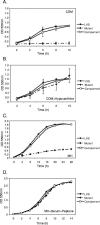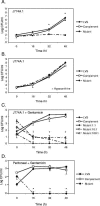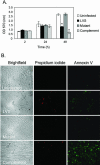Construction and characterization of an attenuated purine auxotroph in a Francisella tularensis live vaccine strain
- PMID: 16861631
- PMCID: PMC1539594
- DOI: 10.1128/IAI.00666-06
Construction and characterization of an attenuated purine auxotroph in a Francisella tularensis live vaccine strain
Abstract
Francisella tularensis is a facultative intracellular pathogen and is the etiological agent of tularemia. It is capable of escaping from the phagosome, replicating to high numbers in the cytosol, and inducing apoptosis in macrophages of a variety of hosts. F. tularensis has received significant attention recently due to its potential use as a bioweapon. Currently, there is no licensed vaccine against F. tularensis, although a partially protective live vaccine strain (LVS) that is attenuated in humans but remains fully virulent for mice was previously developed. An F. tularensis LVS mutant deleted in the purMCD purine biosynthetic locus was constructed and partially characterized by using an allelic exchange strategy. The F. tularensis LVS delta purMCD mutant was auxotrophic for purines when grown in defined medium and exhibited significant attenuation in virulence when assayed in murine macrophages in vitro or in BALB/c mice. Growth and virulence defects were complemented by the addition of the purine precursor hypoxanthine or by introduction of purMCDN in trans. The F. tularensis LVS delta purMCD mutant escaped from the phagosome but failed to replicate in the cytosol or induce apoptotic and cytopathic responses in infected cells. Importantly, mice vaccinated with a low dose of the F. tularensis LVS delta purMCD mutant were fully protected against subsequent lethal challenge with the LVS parental strain. Collectively, these results suggest that F. tularensis mutants deleted in the purMCD biosynthetic locus exhibit characteristics that may warrant further investigation of their use as potential live vaccine candidates.
Figures






References
-
- Burke, D. S. 1977. Immunization against tularemia: analysis of the effectiveness of live Francisella tularensis vaccine in prevention of laboratory-acquired tularemia. J. Infect. Dis. 135:55-60. - PubMed
-
- Eigelsbach, H. T., and C. M. Downs. 1961. Prophylactic effectiveness of live and killed tularemia vaccines. I. Production of vaccine and evaluation in the white mouse and guinea pig. J. Immunol. 87:415-425. - PubMed
Publication types
MeSH terms
Substances
Grants and funding
LinkOut - more resources
Full Text Sources
Other Literature Sources

